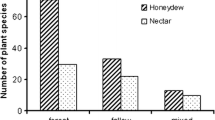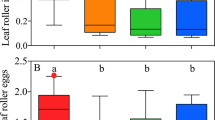Abstract
In Peninsular Malaysia ten species of lycaenid butterflies use leaf flushes or inflorescences of the legume tree Saraca thaipingensis as larval hostplant. Resource partitioning among these species is regulated by a complex mixture of patterns of interaction with ants. Females of obligately myrmecophilous species lay their eggs exclusively on trees colonized by their specific host ants. On trees colonized by weaver ants, only specialist mutualists adapted to these territorial ants are able to survive, while larvae of other species are killed. The formicine ant Cladomyrma petalae, which inhabits hollow twigs of the myrmecophytic hostplant, likewise precludes oviposition by female butterflies. Lycaenid larvae confronted with this ant species never survive, but one concealed feeding species (Jamides caeruleus) escapes removal due to the cryptic life-habits of the larvae. Two facultative myrmecophiles associate in a mutualistic way with a wide and largely overlapping range of ant genera which forage at the extrafloral nectaries of leaf flushes. One species (Cheritra freja) is not myrmecophilous, but is tolerated by all but the most territorial ants. Ant-dependent hostplant selection and egg-clustering characterize the obligate mutualists, whereas facultative myrmecophiles and the non-myrmecophile distribute their eggs singly over appropriate hostplants. Signals mediating caterpillar-ant communication are highly specialized in one obligate myrmecophile (Drupadia theda), but rather unspecific in four other species tested. Altogether our observations indicate that colonization and establishment of lycaenid butterflies on S. thaipingensis trees are governed by specializations as well as opportunistic use of resources (ants and hostplant parts). Therefore, the diversity of this species assemblage is maintained by deterministic as well as stochastic factors.
Similar content being viewed by others
References
Atsatt PR (1981) Lycaenid butterflies and ants: selection for enemy-free space. Am Nat 118:638–654
Beattie AJ (1985) The evolutionary ecology of ant-plant mutualisms. Cambridge University Press, Cambridge, UK
Benson WW (1985) Amazon ant-plants. In: Prance G, Lovejoy T (eds) Amazonia. Pergamon Press, Elmsford, pp 239–266
Bolton B (1994) Identification guide to the ant genera of the world. Harvard University Press, Cambridge, Mass
Corner EJH (1988) Wayside trees of Malaya, 3rd edn, vol 1. Malayan Nature Society, Kuala Lumpur
Cottrell CB (1984) Aphytophagy in butterflies: its relationship to myrmecophily. Zool J Linn Soc 79:1–57
Cushman JH, Rashbrook VK, Beattie AJ (1994) Assessing benefits to both participants in a lycaenid-ant association. Ecology 75:1031–1041
de Vries PJ (1991a) Evolutionary and ecological patterns in myrmecophilous riodinid butterflies. In: Huxley CR, Cutler DF (eds) Ant-plant interactions. Oxford University Press, Oxford, pp 143–156
DeVries PJ (1991b) Mutualism between Thisbe irenea larvae and ants, and the role of ant ecology in the evolution of larval-ant associations. Biol J Linn Soc 43:179–195
DeVries PJ, Baker I (1989) Butterfly exploitation of a plant-ant mutualism: adding insult to herbivory. J N Y Entomol Soc 97: 332–340
Eliot JN (1992) The butterflies of the Malay Peninsula, 4th edn. Malayan Nature Society, Kuala Lumpur
Fiala B, Linsenmair KE (1995) Distribution and abundance of plants with extrafloral nectaries in the woody flora of a lowland primary forest in Malaysia. Biodivers Conserv 4:165–182
Fiala B, Linsenmair KE, Maschwitz U (1994) Diversität von Interaktionen zwischen Ameisen und Pflanzen im südostasiatischen Regenwald. Andrias 13:169–178
Fiedler K (1991) Systematic, evolutionary, and ecological implications of myrmecophily within the Lycaenidae (Insecta: Lepidoptera: Papilionoidae). Bonner Zool Monogr 31:1–210
Fiedler K (1992) The life-history of Surendra florimel Doherty 1889 (Lepidoptera: Lycaenidae) in West Malaysia. Nachr Entomol Ver Apollo Frankfurt NF 13:107–135
Fiedler K, Hölldobler B (1992) Ants and Polyommatus icarus immatures (Lycaenidae) — sex-related developmental benefits and costs of ant attendance. Oecologia 91:468–473
Fiedler K, Maschwitz U (1988) Functional analysis of the myrmecophilous relationships between ants (Hymenoptera: Formicidae) and lycaenids (Lepidoptera: Lycaenidae). II. Lycaenid larvae as trophobiotic partners of ants — a quantitative approach. Oecologia 75:204–206
Fiedler K, Maschwitz U (1989a) Functional analysis of the myrmecophilous relationships between ants (Hymenoptera: Formicidae) and lycaenids (Lepidoptera: Lycaenidae). I. Release of food recruitment in ants by lycaenid larvae and pupae. Ethology 80:71–80
Fiedler K, Maschwitz U (1989b) The symbiosis between the weaver ant, Oecophylla smaragdina, and Anthene emolus, an obligate myrmecophilous lycaenid butterfly. J Nat Hist 23:833–846
Fiedler K, Saam C (1995) Ants benefit from attending facultatively myrmecophilous Lycaenidae larvae: evidence from a survival study. Oecologia 104:316–322
Fiedler K, Seufert P (1995) The mature larva and pupa of Semanga superba (Lepidoptera: Lycaenidae). Nachr Entomol Ver Apollo Frankfurt NF 16:1–12
Gilbert LE (1984) The biology of butterfly communities. Symp R Entomol Soc Lond 11:41–54
Gilbert LE, Singer MC (1975) Butterfly ecology. Annu Rev Ecol Syst 6:365–397
Hochberg ME, Clarke RT, Elmes GW, Thomas JA (1994) Population dynamic consequences of direct and indirect interactions involving a large blue butterfly and its plant and red ant hosts. J Anim Ecol 63:375–391
Hölldobler B, Wilson EO (1990) The ants. Harvard University Press, Cambridge, Mass
Horvitz CC, Schemske DW (1984) Effects of ants and an ant-tended herbivore on seed production of a neotropical herb. Ecology 65:1369–1378
Huxley CR, Cutler DF (eds) (1991) Ant-plant interactions. Oxford University Press, Oxford
Janzen DH (1966) Coevolution of mutualism between ants and acacias in Central America. Evolution 20:249–275
Kitching RL (1981) Egg clustering and the southern hemisphere lycaenids: comments on a paper by NE Stamp. Am Nat 118: 423–425
Koptur S (1992) Extrafloral nectary-mediated interactions between insects and plants. In: Bernays E (ed) Insect-plant interactions, vol IV. CRC Press, Boca Raton, pp 82–129
Maschwitz U, Wüst M, Schurian K (1975) Bläulingsraupen als Zuckerlieferanten für Ameisen. Oecologia 18:17–21
Maschwitz U, Schroth M, Hänel H, Tho YP (1984) Lycaenids parasitizing symbiotic plant-ant partnerships. Oecologia 64:78–80
Maschwitz U, Schroth M, Hänel H, Tho YP (1985) Aspects of the larval biology of myrmecophilous lycaenids from West Malaysia (Lepidoptera). Nachr Entomol Ver Apollo Frankfurt NF 6: 181–200
Maschwitz U, Fiala B, Moog A, Saw LG (1991) Two new myrmecophytic associations from the Malay Peninsula: ants of the genus Cladomyrma (Formicidae: Camponotinae) as partners of Saraca thaipingensis (Caesalpiniaceae) and Crypteronia griffithii (Crypteroniaceae). Insectes Soc 38:27–35
Medway L (1972) Phenology of a tropical rainforest in Malaya. Biol J Linn Soc 4:117–146
Moog J, Maschwitz U (1994) Associations of Cladomyrma (Hymenoptera: Formicidae: Formicinae) with plants in SE Asia. In: Lenoir A, Arnold G, Lepage M (eds) Les insects sociaux. Université Paris Nord, Paris, p 173
Nash DR (1989) Cost-benefit analysis of a mutualism between lycaenid butterflies and ants. DPhil thesis, University of Oxford, Oxford
Peterson MA (1993) The nature of ant attendance and the survival of larval Icaricia acmon (Lycaenidae). J Lepid Soc 47:8–16
Pierce NE (1983) The ecology and evolution of symbioses between lycaenid butterflies and ants. PhD thesis, Harvard University, Cambridge, Mass
Pierce NE (1984) Amplified species diversity: a case study of an Australian lycaenid butterfly and its attendant ants. Symp R Entomol Soc Lond 11:197–200
Pierec NE, Easteal S (1986) The selective advantage of attendant ants for the larvae of a lycaenid butterfly, Glaucopsyche lygdamus. J Anim Ecol 55:451–462
Pierce NE, Elgar MA (1985) The influence of ants on host plant selection by Jalmenus evagoras, a myrmecophilous lycaenid butterfly. Behav Ecol Sociobiol 16:209–222
Pierce NE, Kitching RL, Buckley RC, Taylor MFJ, Benbow KF (1987) The costs and benefits of cooperation between the Australian lycaenid butterfly, Jalmenus evagoras, and its attendant ants. Behav Ecol Sociobiol 21:237–248
Pierce NE, Nash DR, Baylis M, Carper ER (1991) Variation in the attractiveness of lycaenid butterfly larvae to ants. In: Huxley CR, Cutler DF (eds) Ant-plant interactions. Oxford University Press, Oxford, pp 131–142
Sachs L (1992) Angewandte Statistik, 7th edn. Springer, Berlin Heidelberg New York
Samson PR, O'Brian CF (1981) Predation on Ogyris genoveva (Lepidoptera: Lycaenidae) by meat ants. Austr Entomol Mag 8:21
Vane-Wright RI (1978) Ecological and behavioural orgins of diversity in butterflies. Symp R Entomol Soc Lond 9:56–70
Wagner D (1993) Species-specific effects of tending ants on the development of lycaenid butterfly larvae. Oecologia 96:276–281
Wagner D (1994) Species-specific effects of tending ants on the life history of Hemiargus isola, a North American lycaenid butterfly. PhD thesis, Princeton University, Princeton
Way MJ (1963) Mutualism between ants and honeydew-producing Homoptera. Annu Rev Entomol 8:307–344
Way MJ, Cammel ME, Bolton B, Kanagaratnam P (1989) Ants (Hymenoptera: Formicidae) as egg predators of coconut pests, especially in relation to biological control of the coconut caterpillar, Opisina arenosella Walker (Lepidoptera: Xyloryctidae), in Sri Lanka. Bull Entomol Res 79:219–233
Whitmore TC (1988) Forest types and forest zonation. In: Cranbrook Earl of (ed) Key environments: Malaysia. Pergamon Press, Oxford, pp 20–30
Author information
Authors and Affiliations
Rights and permissions
About this article
Cite this article
Seufert, P., Fiedler, K. The influence of ants on patterns of colonization and establishment within a set of coexisting lycaenid butterflies in a south-east Asian tropical rain forest. Oecologia 106, 127–136 (1996). https://doi.org/10.1007/BF00334414
Received:
Accepted:
Issue Date:
DOI: https://doi.org/10.1007/BF00334414




